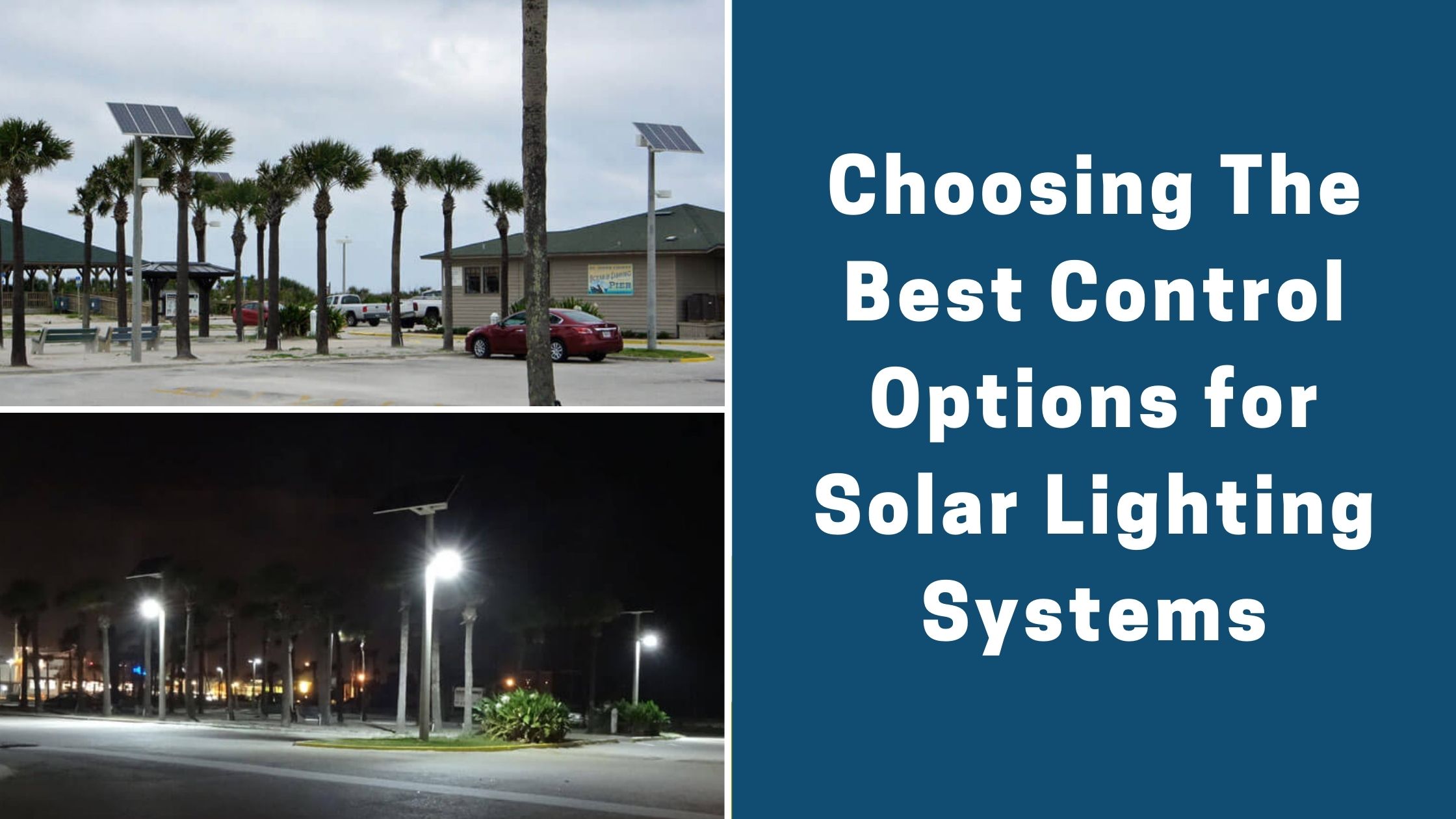Choosing The Best Control Options for Solar Lighting Systems

Contents
When designing a lighting application, run time isn’t always at the forefront of the thought process. However, with off-grid commercial solar lights, the light operation and control options are at the forefront of thought for any solar designer. Since the lights don’t rely on the endless power provided by the grid, and only a limited power source from the sun and the batteries, understanding the various lighting requirements and availability of the sun is key to understanding system constraints.
Every lighting application has different requirements, and there are many custom options to control commercial solar lights. These options allow for peak efficiency and specific lighting during times required by a specific project. The options vary from full intensity dusk to dawn operation, to having the lights operate only a few hours after dusk, sometimes even with a morning operation, or allow for dimming, motion, and other types of controls. Let’s go over these control options and why each has its own place for a project.
Dusk to Dawn
Dusk to dawn is the most popular run time option, not because it is always required, but because it is the most commonly known. Dusk to dawn operation means that the light comes on at dusk and operates at full intensity until dawn, which can be up to 13-15 hours later in many locations.
The light, if sized correctly, will do exactly as suggested, turn on at dusk and turn off at dawn. The light should also have no reduced output or off times for this type of operation. Since commercially designed lights should be sized according to worst case, this is the longest operation available and uses the most amount of power, requiring the largest solar power assembly and battery backup. It is typically the best option for solar street lights and some solar parking lot lights.
DAT or Split Time
Dusk activated timers (DAT) are used for when the lights only need to operate a certain time frame after dusk and then can shut off for the remainder of the night. These settings are used for situations such as a business that closes at 10 pm and all activity will end by 11 pm. Having the lights turn off around midnight or so would ensure proper lighting during active times, but is not needed afterward.
Split time is the same as the DAT setting but also allows for an early morning operation. This type of setting is used in areas where there will be activity before dawn and the lights need to come back on one to two hours beforehand. This is also great with some applications where the dusk to dawn option was too costly, but you want to show that the lights were on all night.
This lowers the power consumption by having a short “off” period and saves energy throughout the night and lowers the amount of solar and battery backup that is required. Best practices for this type of setting would be for solar sign lights, solar park lights, and solar pathway lights.
Motion and Switches
There are two main reasons to use motion sensors; activity reduces and comes back various times throughout the night like for shift changes, or the area is inactive for a majority of the time and would only need to have illumination for safety or security needs. Both options have their best practices and best situational uses. Let’s look at them more in-depth.
Motion for shift changes or where activity may reduce for a time and then come back around is a great way to utilize motion sensors. In these cases, the systems are set to operate either at a reduced intensity or even off until motion is detected. These are great for companies that have multiple shifts such as retirement homes, factories, remote parking lots, etc.
Motion sensors used for safety and security typically have the lights off and only come on when motion is detected. This is perfect for use with parks that close at dusk, remote areas in a facility or neighborhood, or along perimeters. This allows for plenty of visibility for people in the area after dark and to raise awareness to those who are looking for trespassers; however, the rest of the time, the lights are off and not used.
Other applications that benefit from these setups include solar restroom facilities, solar bus stops, solar mailbox clusters, and solar pavilion lights. All of these can benefit from a motion setup, and some can even use a set of switches or spring-loaded timers in lieu of motion sensors if motion isn’t the best option. Talking overall options and project specifics would give the necessary details to make sure you are getting the correct system setup.
Adaptive Lighting
Finally, a technology now being utilized is adaptive lighting, or dimming features, of solar lights. An LED light can run at full power for part of the night, and then reduce output when lighting isn’t required, but still wanted. The solar lights can also have an option to go back to full power if a sensor is activated in some cases.
This option is becoming more widely used as it lowers the needed power for a large light to run all night when the light output at midnight is different than at 9 pm. Adaptive lighting options are best used for solar parking lot lights, solar streetlights in residential or remote areas, and solar pathway lights since all of these may have the want to have lighting all night for safety, but the need for full intensity isn’t required.
Why so many options?
These options exist for many reasons, but the main reason would be to lower the amount of solar required on a project or increase the output during active times. For example, a northern factory may have a shift change at 4 pm and again at 12 am with a break at 4 am.
The lights need to be on at full intensity when people are moving around their vehicles, but when people are inside working, the lights are sitting at a reduced output. If someone needs to come and go between those main times, the lights would be able to come back to full intensity and reduce again once motion is no longer detected. This would be a perfect solution for a motion-sensing system that operates from dusk to dawn at a reduced output with a motion to full.
Or you may have a park that closes at sunset, but because it is nearby a neighborhood, added security is implemented to ensure that if the kids go play at midnight, not only would security or law enforcement be able to see them, the kids wouldn’t be hurt by lack of visibility. So having the lights off unless the motion is detected would be a perfect solution for this project.
Unless the lights are necessary for all-night operation, say the main roadway, dusk to dawn operation is more rarely required than is initially let on. Remember that dusk to dawn is the most expensive option since it will always require the most amount of solar and battery. There are countless ways to reduce the operation by customizing the solution to your needs.
So next time you are looking into lighting, especially solar lighting, find out exactly what your needs are. We can offer a wide range of options to lower the power needs while helping you achieve a green image by installing solar lighting.

